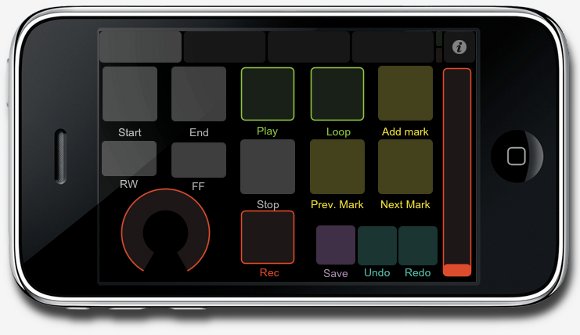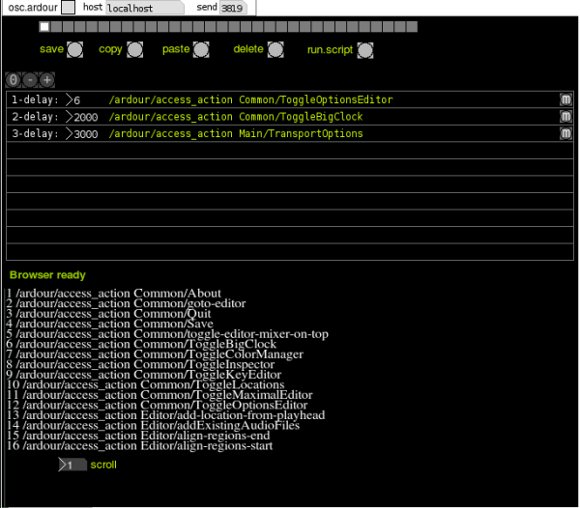Why wait for The Future, when you can have a full-featured DAW that supports OSC (OpenSoundControl), right now, today? That DAW turns out to be Ardour, the open source workstation software that’s been maturing surprisingly nicely, and runs on both Mac OS X and Linux.
Ardour has had OSC support for some time, but early this year, it got proper documentation. Setup is absurdly simple: there’s a single menu item to check off at Options > Misc Options > Use OSC. If you’re using any recent build, it’ll be there – no need for the bleeding edge. (If you want to adjust the port on which Ardour listens, there’s a single line to edit in a configuration file, though the default will probably work just fine.)
Check the menu item, and Ardour is ready to receive OSC messages, meaning it’d be really easy to build an OSC-compliant control surface from hardware or software. (I probably shouldn’t mention this in public, but I’ve started a simple remote control for Android. If you have feature requests or an idea of how it should work, let me know. One thing I’d like is to use Android’s gesture library for making menu shortcuts. I only bring this up in case anyone is interested in helping.)
The advantage of OSC over MIDI or even traditional keymaps is that there’s no translation of one thing to something else. Ardour simply responds to any message sent to any menu item. The message for Save, then, is Save. The message “edit cursor to previous region start” is edit-cursor-to-previous-region-start. Everything is described in human-readable English.
It’s also not hard to look at the OSC commands and imagine a more generic spec for common, shared commands that would work across DAWs.
Ardour is already a joy to use for audio, especially if you think of it not as an all-in-one app that has every conceivable effect you’d ever need, but as a JACK-enabled host that works with other tools. Little wonder: JACK audio, an ingenious way of routing sound and transport between software on Linux and Mac, is also the creation of lead Ardour developer Paul Davis. (On Linux, I’ve started using the combination as a way of conveniently recording sounds from Pd.)
If you’ve found other DAWs have gotten overcomplicated and want an audio host that focuses on exceling at the basics, Ardour is well worth a look. Of course, for many of us, MIDI editing is a basic we can’t do without, so needless to say a lot of folks are impatient for Ardour. Paul tells me progress is going smoothly, though, so stay tuned – and consider donating at the site if you like what you see and want to support more development. Another way to help: on Mac, there’s the fantastic-looking Mixbus, a commercial version of Ardour that turns it into a full-featured, analog-style mixing console with effects.
And commercial developers, I do hope you’re paying attention, too. Yes, this is something you could do.
Readers: what would you want to see from OSC controllers for a DAW?
Updated: Ardour + TouchOSC
Max Breakwell has blogged the Ardour DAW and also has set up a convenient-looking template for TouchOSC. I agree with Max that one of the big challenges is just picking out what you want to control – you wouldn’t want everything (that’s what the UI is for). On the other hand, it’s great to have that flexibility. Wanted to post this and haven’t yet had time to ask him, but I find it curious that he needs to run Max/MSP in the background to process the ports; I have to find out why.
“Ardour and OSC Ideas” / Ardour mini-review
Needless to say, though, OSC does not have to mean iPhone/iPad, exclusively. OSC hardware is gradually evolving, and other platforms are possible, too — including what promise to be some dirt-cheap, Android-powered tablets later this year. So I’d keep my eye on this one; even if you’re not ready yet, you might find yourself using this combination down the road.
Updated: Ardour + Pd
With OSC control providing full control of everything Ardour does, you wind up with something a little bit akin to the combination of Max for Live and the Ableton Live API calls (Live DOM). Not only could you control Ardour yourself via a tablet or controller or other device, but you could build a patch that provides programmatic control of Ardour. What might you do with that? Well, that’s up to you – it seems it could range from the practical (automating common tasks) to the somewhat unusual.
Apostool is a set of Pd patches that turn Pd into a “scripting” tool for Ardour. Developed by a user by the name of seegwen, it’s in its first steps, but it’s a good place to start if this interests you (and from comments on Twitter and elsewhere, I think it might). In case this seems like a distraction, too, there’s no reason not to keep such a patch simple, pulling only what you want to manipulate – indeed, it’s likely faster than some MIDI assignments and the like would be.
There’s a great discussion on the Ardour forum, which even raises the possibility of “algorithmic mixing.” Dave Phillips, the awesome Linux audio author, even chimes in with some ideas of other software that could get in on the fun. Sure, it sounds intensely geeky, but because of the potential simplicity of the tools involved, there’s no reason you couldn’t come up with a simple project and make some actual music with these ideas.
Apostool, Ardour Puredata Osc Scripting tool [Ardour forum]
Apostool – Puredata – Gwen [Project page]
And MIDI… For all the MIDI gear you’ve got that does MIDI and not OSC, Ardour needs your help creating mappings:
We Need You: creating MIDI controller mappings for Ardour 3


